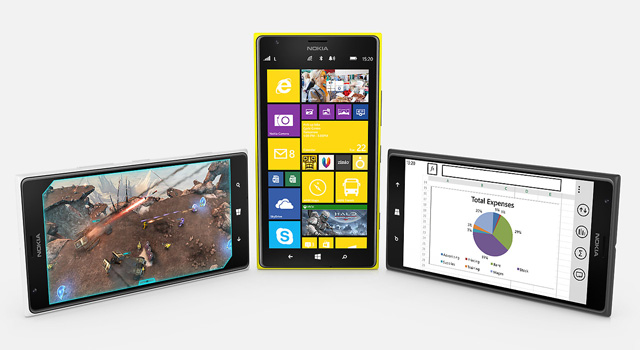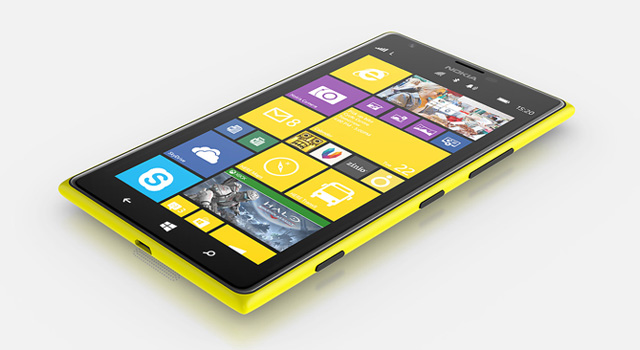
The Lumia 1520 is Nokia’s first attempt at a phablet, a cross between a smartphone and a tablet. It was announced in October last year at Nokia World in Abu Dhabi, alongside the midrange 1320 phablet. (There has been no word on whether the 1320 will make its way to South Africa.)
The 1520 has the same signature look as all other unibody polycarbonate Lumia handsets. The yellow device we have on review has been turning heads, so if you want a colour that stands out, this is it. It is also available in a more staid black or white. The device is wide and long in shape, so when you hold it in one hand it’s not possible to scroll with your thumb. It has dimensions of 162,8mm x 85,4mm x 8,7mm and weighs 209g.
Like all other Lumia handsets, the main buttons are to the right hand side — volume keys, power and camera buttons. To the left is the Sim card and micro SD slots, and there’s a 3,5mm audio jack on the top and a micro USB charging port at the bottom.
It came as a surprise that the 1520 uses a nano Sim (the only smartphone we’ve come across that uses one other than the iPhone), so if you’ve experienced the pain of converting to a micro Sim with your last upgrade, be prepared to do it all over again.
The 6-inch IPS LCD Gorilla Glass display is the first Windows Phone with a full HD display. It has a gorgeous 1 920×1 080-pixel resolution, with a density of 368ppi. The screen is amazing, thanks to “assertive display” technology that adjusts when you move outdoors. It adapts the colour and brightness of each pixel when you’re in brighter conditions. You can continue watching a video, or read text on a white background effortlessly when you head outside. You can also take pictures in direct sunlight and still see everything on the display.
The screen size is great for reading magazines or watching videos on the go without feeling like a scaled-down tablet experience. The larger size also makes way for another column of live tiles on the homescreen. It’s handy as you have access to more shortcuts from a single view than having to scroll down for more. You are able to play around with sizes of the tiles and have three choices: mini, and regular and large for dynamic content.
Under the bonnet is a speedy 2,2GHz quad-core Qualcomm Snapdragon 800 processor with 2GB of RAM and 32GB of built-in storage, which is expandable through microSD. The phablet didn’t stutter and managed to get the job done from using multiple browser tabs, playing games, using lots of apps and switching between them, and making use of the camera. It did exactly what we wanted it to do without a hitch — and there wasn’t a single app that crashed. The handset runs the latest Windows Phone 8 version.
The Windows Phone store is still playing catch up when it comes to the selection of apps, though — and this remains a problem for the platform. The one app everyone waited months for, Instagram, was one of the first apps we downloaded. Still in beta, it offers a slightly different experience to the Android and iOS versions.

We’re not sure why, but the unofficial Instagram app called 6tag comes preloaded on the handset, along with a selection of Bing apps (news, weather, finance, sport), Data Sense, Facebook, News24, Office, OneNote, SuperSport, Twitter and Zinio. As expected, Nokia-exclusive apps are also preloaded, such as Here Maps, Here Drive, Nokia Music, Camera, Screen Beamer and StoryTeller.
Data Sense is a nifty app that dynamically displays your data usage on both 3G and Wi-Fi. At a quick glance from the homescreen you are able to keep track of how much data you’ve used.
A key app that’s still missing from the Windows Phone store is Flipboard — an app we use daily and missed having. Microsoft’s (recently rebranded) OneDrive app proved to be quite useful when it came to sharing photos from the camera roll; it beats connecting a cable or sending via email any day. Just make sure you’re on a Wi-Fi network before using it to avoid bill shock.
On the connectivity front, the handset supports near-field communication, Bluetooth 4.0, micro USB, USB 2.0, and Wi-Fi. We found the Wi-Fi range not as good as other devices. A great connectivity feature is the ability to find Wi-Fi nearby. It uses your location to display hotspots near you, via Here maps. You are able to zoom in and out of areas anywhere to see what hotspots are listed.
The camera on the Lumia 1520 is a 20-megapixel shooter with a CMOS sensor and dual LED flash. It has an f2.4 lens, optical image stabilisation and manual controls. It’s a PureView-branded camera, as seen on the Lumia 1020, with the same lossless zoom and pixel oversampling feature where images taken in full resolution are reduced to a lower resolution, so 20-megapixel shots will be available in five megapixels when posting to social networks or to e-mail.
The camera on the 1520 doesn’t shoot images instantaneously, but there is a “smart sequence” feature to take continuous shots by holding the camera steady. Manual controls that appear on-screen lets you adjust white balance, focus, shutter speed, brightness and sensitivity. It records video in full 1080p HD. The camera also has four microphones for directional stereo recording, which works great for concerts.
Overall, on the hardware front, the Lumia 1520 has everything you’d want from a phone. It has a stunning display, fantastic camera and other high-end specs, but offers a somewhat limited app selection. It could very well be the best Windows Phone to date — we think it is — but at six inches it’s a niche handset and buyers must be certain a phablet is what they’re after. — (c) 2014 NewsCentral Media
- The Lumia 1520 costs about R9 500 outside of a contract




